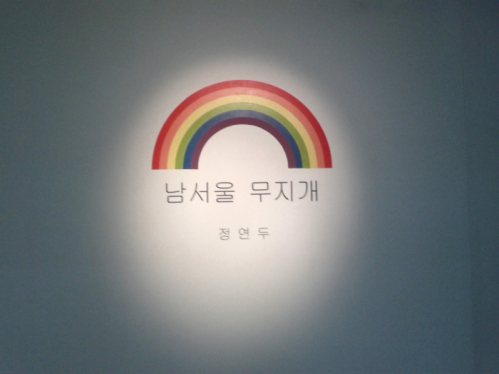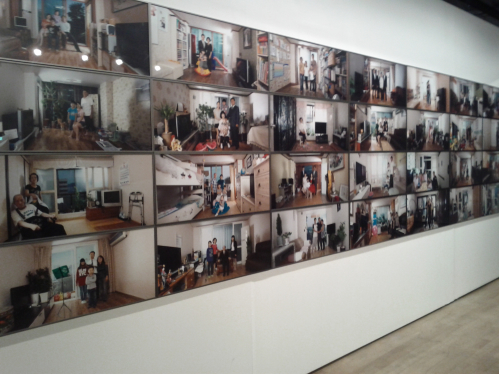Week in Review: Residency in Seoul, South Korea, Part 2

Photo by Kristin Juarez.
Artist Yeondoo Jung opened his exhibition, Southern Rainbow Seoul, here at Seoul Art Space Geumcheon (SASG). The result of a call for participants, the show is a series of portraits of individuals and families living in the apartment complex called Southern Rainbow Seoul. Asking people to open up their homes, Jung and exhibition-goers gain a glimpse into the private sphere through the lives of some of the building’s inhabitants. Together, the photographs act as a commentary on living conditions and the growing popularity of apartments (land is critical in Seoul), as well as a look into how people represent themselves. Promising a free photograph for their time, Jung gave the sitters little direction for how they should pose, leaving it up them to compose their portraits.

Photo by Kristin Juarez.
For the 2011 Incheon Women Artists’ Biennale, the theme Terra Incognita is meant to probe the status of the world as we know it, bringing into light artistic exploration of parallel universes. Works in the main exhibition (there are three other satellite exhibitions) move across a range of possible meanings, challenging the boundaries of outer/cyber/public/personal space. As a result, the art’s content expressed individual and collective identity, from the intimacy of family, to the borders dividing ethnic groups, to the ever-expansive scale of outer space.
The main exhibition included works by Yoko Ono, Yael Bartana, Joan Jonas, and Wangechi Mutu. LaToya Ruby Frazier is one artist whose work gave a richer meaning to the theme of parallel universes. Her video and photography work is set in Braddock, Pennsylvania—her hometown—and it documents her family through three generations of women living in a former steel-mill town. Working in collaboration with her mother, Frazier creates a family portrait that depicts a larger collective reality for many in Braddock. Her work is present in both the main exhibition and the satellite exhibition, Tuning.
While the main exhibition does not deliberately highlight the biennale as a site for women’s art, Tuning seeks to insert critical thought into the exhibition. More to come after I visit Tuning.
Another show, After Humanism at Alternative Art Space Loop, includes a video work, My Voice Would Reach You, by Japanese artist Meiro Koizumi. The video focuses on a man having a circular, heart-wrenching conversation over the phone with someone who, at first, you think is his mother. We don’t hear the voice on the other line. Perhaps she is suffering from an illness like dementia? Then, we come to realize that he is in fact speaking with various telephone operators. Koizumi constructs a highly emotional scene for the viewer to experience, and then shows us the construction of the scene, illuminating our own projections onto his work. The artist throws his formal strategies—the actor, the music, the script, the editing—into the spotlight, showing the tools he employed to create the viewer’s emotional connection to the work.
The exhibition at Sangsangmadang, Goodmoney, takes a look at socially engaged creative practices, including documentation of a TOMS shoe-drop in South Korea and a prototype for a $300 house. The show includes a video documenting social interventions by Eva Jung entitled The Samples of Emotions (Chinatown, New York). Setting up a modest meeting spot on the street and at markets, Jung invited participants to share a story of either happiness or sadness in exchange for a gift that represents the opposite emotion. The gift, a small bundle of pink plastic and tissue paper, is a small gesture that encapsulates the emotion.
Jung’s video shows the transformation that occurs through this act of storytelling. It begins with people sitting down with a certain amount of amusement and curiosity. For those who “give” sadness, we watch as their body language and facial expressions change with their personal stories. Though we are not able to hear the stories, it provokes empathy as the viewer projects their own stories onto the participants. The small action of giving the bundle, which Jung first splits to reveal the colorful inside, is a moment of visible catharsis for the participants. Viewers only learn at the ending credits what some of the stories were. Since you can’t put a face to these stories, you are once again asked to imagine and empathize with a stranger.
Kristin Juárez is the author of our monthly column, The Fringe, and is conducting a residency in Seoul, South Korea, through October 28, 2011. Click here to read Seoul Residency, Part 1.
* the article has quoted from
http://www.burnaway.org/2011/10/week-in-review-residency-in-seoul-south-korea-part-2/

